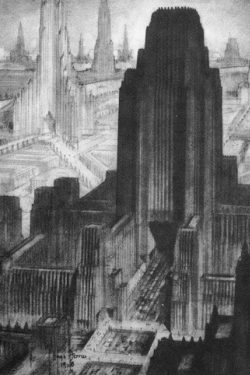In the 1920s, a new vision of the future swept American culture: a skyscraper city of monumental towers, multilevel highways, aerial transport, and densely developed commercial districts. An invention principally of New York architects and planners, this hyper-concentrated urbanism was set forth in dazzling images in exhibitions, newspapers, books, popular magazines, art galleries, department stores, and movies.
The inspiration and motivation for these prophecies were New York itself. Soaring buildings, hurtling subways, and teeming crowds made Gotham uniquely modern. In 1925, New York passed London to become the world’s largest metropolis. With a population of nearly six million in the city proper and ten million in the region, New York was booming, and the crowding in Manhattan’s business districts and phenomenal pace of high-rise development seemed to promise that every block would soon be built anew. Visions of super-scaled setbacks linked by elevated highways and multilevel transit reflected an obsession with the problem of congestion, as well as optimism that the new tool of zoning offered a way to regulate and channel capitalist growth.
Forecasts of the future city generally extrapolate present-day fears or enthusiasms. As politically naive, alienating, or simply fantastic as many of these prophecies seem today, an essential insight of their collective vision is clear: skyscrapers would define the urban future. Indeed, as skyscrapers spread around the globe, no place better predicted the future of the modern city than New York itself.
Carol Willis
Carol Willis is the founder and director of the Skyscraper Museum and a professor of Urban Studies at Columbia University’s Graduate School of Architecture, Preservation and Planning. She is also the author of Form Follows Finance and co-author of Building the Empire State with Donald Friedman.
